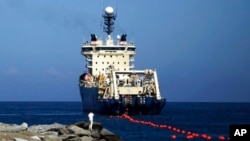Undersea cables that carry the bulk of intercontinental internet traffic are increasingly the focal point of geopolitical tensions involving China, according to experts.
Justin Sherman, a fellow at the Cyber Statecraft Initiative of the Atlantic Council, a Washington think tank, told Reuters, "When we talk about U.S.-China tech competition, when we talk about espionage and the capture of data, submarine cables are involved in every aspect of those rising geopolitical tensions."
The cables are a hot spot in China's relations with Taiwan, a self-governing island that Beijing considers its own territory — a long-standing point of contention between the U.S. and China.
VOA Mandarin contacted the Chinese Embassy in Washington and the Foreign Ministry in Beijing asking for a comment but was told the Chinese government had no comment on undersea cables.
Last month, the cables were cut between Taiwan and the Matsu Islands, which are controlled by Taiwan but lie just off the coast of China. Taiwan's government stopped short of accusing the Chinese government of cutting the cables on purpose, and the National Communications Commission said two ships severed the cables accidentally.
The cables have been cut 27 times during the past five years, according to data from Taiwan's Chungwha Telecom quoted by The Associated Press. Each cable is about as wide as a garden hose once the fiber-optic technology inside is wrapped with insulating materials so it can be laid on the seabed, where it is exposed to threats including earthquakes, typhoons, ships' anchors and saboteurs.
Elisabeth Braw, a senior researcher at the American Enterprise Institute, speculated in a February 21 article in Foreign Policy magazine that the cut cables may be the result of targeted harassment of Taiwan by China.
She told VOA Mandarin that over the past few years, "Chinese fishing vessels and other commercial vessels have been harming the cables connecting the Matsu islands to Taiwan a disproportionate number of times. … And the challenge for Taiwan is that it's not a military attack.
"And China can say, 'Oh, it was just commercial vessels,' and they didn't deliberately harm or cut the cables. And it's impossible for Taiwan to prove that it was deliberate. And so it's very hard to retaliate, and it's also very hard to protect those cables. You can't have your navy out 24 hours a day just sitting on top of the cables to make sure nobody harms or cuts them."
Military implications
The loss of the internet cables and the connectivity they provide has huge military implications, as Russia has shown by targeting internet infrastructure in its assault on Ukraine.
Joseph Hwang, an affiliate faculty member at George Mason University, told VOA Mandarin that fixing the cables severed last month would take time and money.
"Due to limited international funding, emergency repairs are expected to arrive on April 20 at the earliest," he said. He estimated repairs would cost between $329,500 and $659,000 in U.S. dollars.
He suggested that Taiwan, U.S. and Asian allies should strengthen undersea infrastructure by investing in cable armor, deeper burial and decoy cables, and consider establishing legal frameworks that clearly explain the consequences of accidental or intentional underwater cable destruction.
In an article in The Hill, Dan Blumenthal and Frederick W. Kagan, scholars at the American Enterprise Institute, said that if China invades Taiwan, "China can cut off lines of communication and interdict military and civilian supplies by air and sea, then Taiwan eventually would have to capitulate."
James Holmes, the J.C. Wylie chair of maritime strategy at the U.S. Naval War College, told VOA Mandarin it's unsurprising that China would dive underwater to bring pressure on Taiwan and isolate the island from the world. He said the best pushback against such tactics is deterrence.
"China's and Russia's undersea connections to the outside world are as vulnerable as anyone else's, and Beijing and Moscow must know it," he said. "So, we may be looking at another form of conventional, mutual assured destruction as gray-zone competition dives underwater."
Gray-zone actions are those waged by one government to gain advantage over another in a way that does not provoke a conventional military response, according to a Center for Strategic and International Studies report.
US actions
In at least six private undersea cable deals over the past four years, the U.S. government has either intervened to keep HMN Tech, a subsidiary of the sanctioned Chinese firm Huawei, out of the undersea cable business in the Asia-Pacific region or it has forced the rerouting or abandonment of cables that would have directly linked U.S. and Chinese territories, according to Reuters.
As of early 2023, there were more than 550 active and planned submarine cables worldwide, according to TeleGeography, a telecommunications market research and consulting firm in Washington, which figures there are nearly 1.4 million kilometers of submarine cables in service globally.
Undersea cables carry over 99.4% of intercontinental internet traffic, Jayne Miller, spokesperson for TeleGeography, told VOA Mandarin via email. "Even with lots of satellite constellation launches, the capacity of a single submarine cable dwarfs that of many satellites combined," she said.
"Cables can carry far more data at far less cost than satellites," according to the TeleGeography website. U.S. government figures "indicate that satellites account for just 0.37% of all U.S. international capacity."
The cables are laid between locations that need to communicate. A map of the world's undersea cables shows almost two dozen cables connecting North America with Asia and fewer than 20 connecting Europe and North America. There are fewer than five cables connecting Africa and South America, and no cable connecting Australia and South America.












